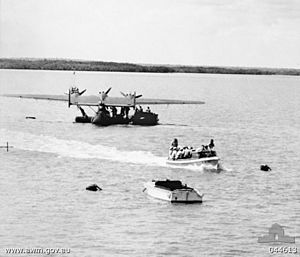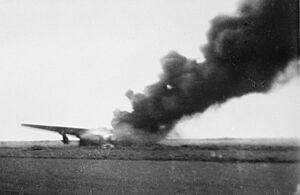Attack on Broome facts for kids
Quick facts for kids Attack on Broome |
|||||||
|---|---|---|---|---|---|---|---|
| Part of World War II, Pacific War | |||||||
 Personnel from a Royal Netherlands Navy Air Service Dornier Do 24 are transported by launch in Darwin Harbour, May 1941, several months before the attack on Broome |
|||||||
|
|||||||
| Belligerents | |||||||
| Commanders and leaders | |||||||
| Strength | |||||||
| 22 aircraft | 10 aircraft | ||||||
| Casualties and losses | |||||||
| 88 killed (official toll) 22 aircraft destroyed |
1 killed (official toll) 2 aircraft destroyed |
||||||
The town of Broome, in Western Australia, was attacked by Japanese fighter planes on March 3, 1942. This happened during World War II. At least 88 people, including civilians and Allied military staff, were killed.
Broome was a small town known for pearling. But it was also a very important stop for planes. These planes flew between the Dutch East Indies (now Indonesia) and major Australian cities. Because of this, Broome became a key place for people escaping the war.
Many people, especially from the Netherlands, were fleeing the Japanese invasion of Java. They often traveled in flying boats, which were like airliners back then. In just two weeks in early 1942, over a thousand refugees passed through Broome. Most of these were military personnel. About 250 were Dutch civilians, often families of the aircrews.
Contents
Why Broome Was Attacked
Broome was a vital refueling point for Allied aircraft. It was also a safe haven for refugees. This made it a target for the Japanese forces. They wanted to stop Allied planes and disrupt the escape routes.
The Attack Begins
On the morning of March 3, 1942, Zenjiro Miyano, a Japanese commander, led the attack. He brought nine Zero fighter planes and one reconnaissance plane. They flew from their base in Timor.
Around 9:20 AM, the Zeroes began their attack. They flew low and fired their machine guns at the flying boats. These boats were anchored in Roebuck Bay. They also attacked the Royal Australian Air Force (RAAF) base at Broome Airfield. No bombs were dropped, but witnesses might have seen pilots releasing their fuel tanks. The attack lasted for about an hour.
Planes Destroyed and Lives Lost
The Japanese fighters destroyed at least 22 Allied aircraft. One of these was a United States Army Air Forces (USAAF) Consolidated B-24 Liberator bomber. It was full of wounded people and crashed into the sea. Nearly 20 people died in that crash.
Fifteen flying boats were also destroyed while anchored. Many Dutch refugees were on board these boats. The exact number of people killed is not fully known. However, some victims, including nine children, were later identified.
At the airfield, the Japanese destroyed several planes. These included two USAAF B-17E Flying Fortresses and another USAAF B-24. Two RAAF Lockheed Hudsons and a Royal Netherlands East Indies Air Force (ML-KNIL) Lockheed Lodestar were also lost.
The destroyed aircraft included:
- Eight PBY Catalina flying boats from Australia, the Netherlands, the U.S. Navy, and the UK.
- Two Short Empire flying boats from the RAAF and QANTAS.
- Five Dutch Dornier Do 24 flying boats.
A KLM Douglas DC-3 airliner, carrying refugees, was chased and attacked. It managed to land on a beach near Broome. But it was then shot at again. Four people died, and valuable items were stolen from the plane.
Allied Response
There were no Allied fighter planes based in Broome at the time. The Japanese Zeroes faced some light gunfire from the ground. One Japanese pilot, Warrant Officer Osamu Kudō, was killed by ground fire. A Dutch pilot, First Lieutenant Gus Winckel, shot him down. Winckel used a machine gun he had taken from his own plane. He balanced it on his shoulder and got burned while firing. Another Zero ran out of fuel on its way back to base and crashed, but its pilot survived.
Later research in 2010 suggested that Kudo's Zero was shot down by the tail guns of the B-24A Arabian Knight. This B-24A was also shot down by Kudo's attack, and 19 of the 20 American military personnel on board died.
After the Attack
Frank Russell, an RAAF pilot, described the scene as "ghastly devastation." He saw flying boats sending up huge clouds of black smoke. Burning fuel spread across the sea. He also saw constant streams of tracer bullets. Many Dutch flying boats had been full of women and children.
Charlie D'Antoine, an Aboriginal man who refueled flying boats, showed great bravery. He helped two passengers reach the shore. He swam through burning fuel and wreckage to save them. D'Antoine later received an award for his bravery from the Dutch government. He was even invited to a royal reception in the Netherlands.
One U.S. serviceman, Sgt. Melvin Donoho, swam about 16 kilometers (10 miles) to shore from the crashed B-24. This journey took him over 36 hours.
Japanese planes made a few smaller attacks on Broome later. On March 20, 1942, Mitsubishi G4M2 "Betty" bombers attacked the airfield. One civilian was killed, and the ground was damaged. The last attack happened in August 1943.
Legacy and Protection
Over the years, the wrecks of the flying boats become visible during very low tides. Tour guides and visitors often go to see them. These shipwrecks are protected by state law and should not be touched. However, part of a Catalina flying boat's body was believed to have been stolen by November 2020. The RSL said that the wrecks near Broome are war graves and need more protection.
In 2021, amateur historians and a maritime archaeology group began diving. They are creating a database of wrecks around the state. All the flying boats attacked in the water caught fire. They burned down to the waterline, so not much of their original structure remains.
See also
- Battle for Australia
- Western Australian emergency of March 1942


